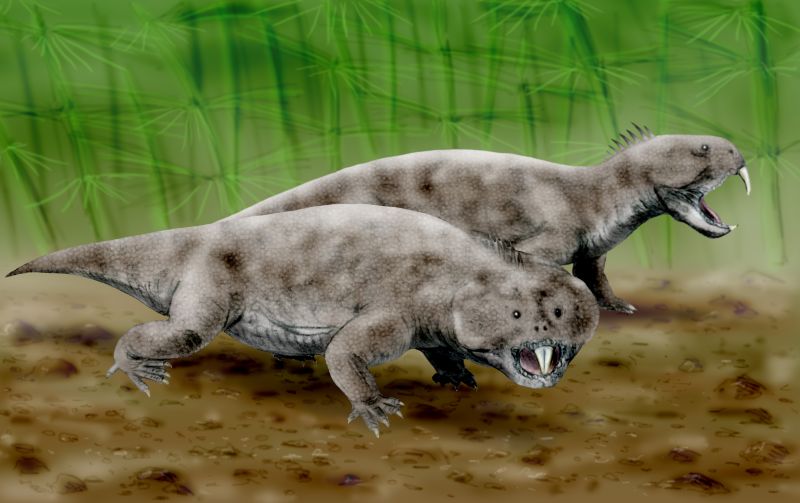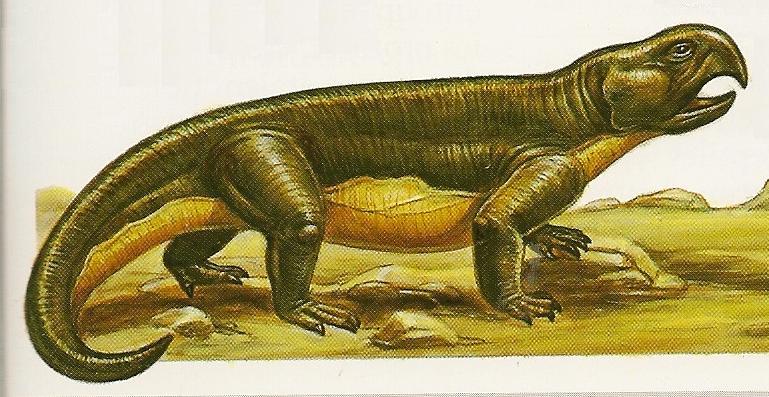[Recent Entries][Archive][Friends][User Info]
Below are the 3 most recent journal entries recorded in the "Сообщество, посвящённое ра" journal:| February 28th, 2012 | |
|---|---|
| 06:00 pm [industrialterro] [Link] |
Rhynchosaurus Rhynchosaurus (beaked lizard) is a genus of rhynchosaur that lived during the Middle Triassic Period. It lived in Europe. It was related to the archosaurs, but not within that group. The species of Rhynchosaurus are R. articeps and R. brodiei. Michael Benton had named a third species, R. spenceri, but it has since been given its own genus, Fodonyx.
Tags: Вымершие рептилии, Триас, архозавроморфы, диапсиды, ринхозавры |
| February 27th, 2012 | |
| 08:24 pm [industrialterro] [Link] |
Hyperodapedon Hyperodapedon is a genus of rhynchosaur (a beaked, archosaur-like reptile) from the late Triassic period (Carnian stage). The type species of Scaphonyx (meaning canoe claw), Scaphonyx fischeri that once thought to be a dinosaur, is now known to be based on dubious material and therefore should be a nomen dubium. The name Paradapedon was erected for the Indian species H. huxleyi (Lydekker, 1881). Benton, 1983, concluded that this rhynchosaur should be considered a species of Hyperodapedon. Hyperodapedon is known from several species and has been found in many areas of the world, due to the continents being joined together in the supercontinent Pangaea during the Triassic. Fossils from the various species have been identified from Argentina, Brasil, India, Scotland and possibly from Canada, USA and Wyoming. It was hunted by many predators like Saurosuchus and Prestosuchus. Hyperodapedon was a heavily built, stocky, animal around 1.3 metres (4.3 ft) in length. Apart from its beak, it had several rows of heavy teeth on each side of the upper jaw, and a single row on each side of the lower jaw, creating a powerful chopping action when it ate. It is believed to have been herbivorous, feeding mainly on seed ferns, and died out when these plants became extinct at the end of the Triassic. Ринхозавры (Rhynchosauria) — группа архозавроморфов, живших в триасовом периоде. Растительноядные, с бочкообразным телом и мощным клювом. Ранние примитивные формы (такие, как Mesosuchus и Howesia) весьма похожи на ящериц. В более поздних и продвинутых формах череп становится короче, приобретает треугольную форму, ширина в задней части становится больше длины. Сильно развита аддукторная мускулатура челюсти. Текодонтный тип крепления зубов сменяется на анкилотекодонтный. Задние ноги снабжены массивными когтями, вероятно, для выкапывания корней и клубней. Подобно многим животным своего времени имели глобальное распространение, по всей Пангее. Являлись одним из главных компонентов фауны в среднем триасе. Вымерли, вероятно, из-за изменения растительности и конкуренции с ранними динозаврами. На основании сходства черепа и зубов длительное время считались родственниками клювоголовых. У некоторых поздних видов есть только одна ноздря, Поздние представители были очень похожи на дицинодонтов и, возможно, именно они вытеснили последних, заняв потом ту же экологическую нишу.
Tags: Вымершие рептилии, Триас, архозавроморфы, диапсиды, ринхозавры |
| 08:01 pm [industrialterro] [Link] |
Mesosuchus Mesosuchus is an extinct genus of basal rhynchosaur from middle Triassic (Anisian stage) deposits of Eastern Cape, South Africa. It is known from the holotype SAM 5882, a partial skeleton, and from the paratypes SAM 6046, SAM 6536, SAM 7416 and SAM 7701 from the Aliwal North Euparkeria site. It was found in the Burgersdorp Formation of the Beaufort Group (Karoo Basin) and referred to the middle Cynognathus Assemblage Zone. It was first named by David Meredith Seares Watson in 1912 and the type species is Mesosuchus browni. Mesosuchus browni (Watson 1912) Early Triassic ~240 mya, ~40cm in length, was found in a sandstone block along with Euparkeria, hence the name, Mesosuchus, which indicates an affinity with crocodilians. Further excavation revealed the two skeletons (Broom 1913a,b) and the relationship of Mesosuchus to rhynchosaurs. Romer (1956) considered rhynchosaurs and sphenodontians to be related, but Benton (1985) and Carroll (1988) mistakenly split them apart by placing too much emphasis on the lack of fusion in the teeth and tarsus rather than considering the suite of characters that more parimoniously unites them. Mesosuchus was derived from a sister to the sphenodontian, Brachyrhinodon and the trilophosaur, Trilophosaurus. Mesosuchus phylogenetically preceded Hyperodapedon and the rest of the Rhynchosauria. Distinct from Brachyrhinodon, the skull of Mesosuchus had distinct teeth not fused to the skull bones. The nares were joined without a central premaxilla bone dividing them. The temporal bars were more gracile with larger temporal openings. The jugal was more gracile. The quadrant leaned anteriorly. The premaxilla extended down further. The cervicals were longer and taller. The vertebral spines were taller. The scapulocoracoid was larger. The manus was smaller. The pelvis had deeper ventral elements and a broad pubic apron. The tarsal elements were not fused together.
Tags: Вымершие рептилии, Триас, архозавроморфы, диапсиды, ринхозавры |










